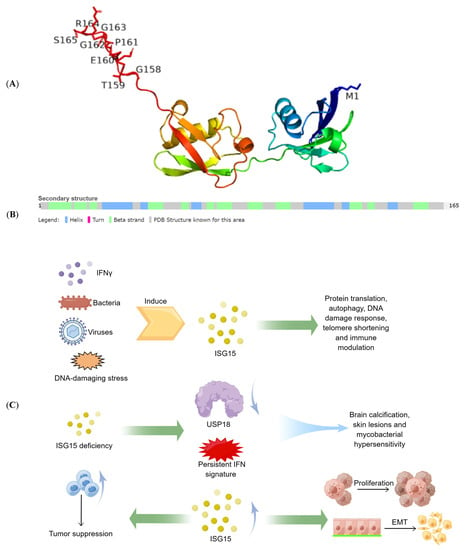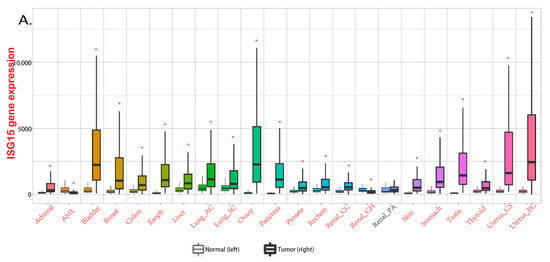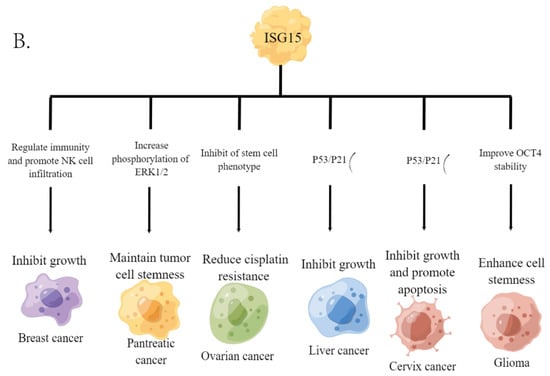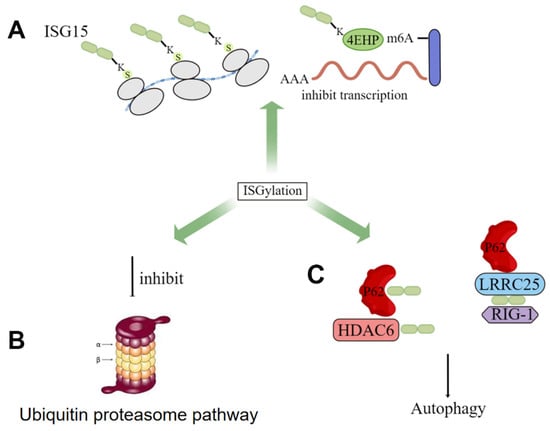The protein ISG15 encoded by interferon-stimulated gene (ISG) 15 is the first identified member of the ubiquitin-like protein family and exists in the form of monomers and conjugated complexes. Like ubiquitin, ISG15 can mediate an ubiquitin-like modification by covalently modifying other proteins, known as ISGylation. There is growing evidence showing that both the free and conjugated ISG15 are involved in multiple key cellular processes, including autophagy, exosome secretion, DNA repair, immune regulation, and cancer occurrence and progression.
1. Introduction
Post-translational modifications (PTMs) are important for protein activities because they modulate structure and function by changing properties such as charge, hydrophilicity/hydrophobicity, and spatial structure [
1].The forms of protein PTMs are various, including phosphorylation [
2], ubiquitination [
3], methylation [
4], acetylation [
5], etc. In recent years, the ubiquitin-like (UBL) modification of proteins has been extensively studied. As a PTM similar to ubiquitination, the proteins mediating UBL modification are structurally and evolutionarily related to ubiquitin. The binding of these UBL proteins to target proteins is also dependent on the level of E1 activating enzymes, E2 binding enzymes, and E3 ligases. The PTM function of UBL proteins is implicated in the nervous system [
6], endocrine system [
6], cardiovascular system [
7], and many other diseases. Currently, the role of UBL modification in tumor occurrence and development is receiving a lot of attention [
8,
9,
10] (
Table 1).
Table 1. UBL proteins and their functions.
|
UBL Proteins
|
E1
|
E2
|
E3
|
Function
|
|
UFM1
|
UBA5
|
UFC1
|
UFL1
|
Ufmylation is involved in reticulophagy (also called ER-phagy)-induced in response to endoplasmic reticulum stress [11]. Ufmylation of TRIP4 regulates nuclear receptor-mediated transcription [12].
|
|
SUMO family
|
SAE1,SAE2
|
Ubc9
|
PIAS, CBX4
|
Regulating protein stability and the interaction between proteins and subcellular localization [13].
|
|
ISG15
|
UBA7
|
UBCH8
|
HERC5, TRIM25
|
Cancer-promoting or -suppressing; Antiviral infection [14].
|
|
NEDD8
|
NAE1
|
UBE2M, UBE2F
|
RBX1, RBX2, FBXO11, c-CBL, DCNL1-5, IAPs, RNF111, RNF111, TFB3, TRIM40
|
Regulating embryonic development, cell division and proliferation [15,16,17].
|
|
UBL3
|
-
|
-
|
-
|
Regulating MHCII and CD86 in human dendritic cells (DCs) and macrophages, regulating immune response [18].
|
|
ATG8
|
ATG7
|
ATG3
|
ATG5-12
|
Regulation of autophagy [19].
|
|
ATG12
|
ATG7
|
ATG10
|
-
|
Involving in autophagy vesicle formation [20].
|
|
FAT10
|
UBA6
|
UBE2Z
|
Parkin
|
Affecting the occurrence,
progression and drug resistance of tumors [21,22].
|
ISG15 is the product of interferon-stimulated gene 15, and its expression is regulated by the interferon signaling pathway. ISG15 was first discovered as an UBL protein in 1979 by Farrel et al. [
23]. The precursor to ISG15 has a total of 165 amino acid residues. Through protease splicing and processing, the N-terminal methionine and the C-terminal 8 amino acid residues (GTEPGGRS) are removed, and a mature protein containing 156 amino acid residues is finally formed (
Figure 1). ISG15 is an UBL protein with the ability to form covalent protein-binding [
24,
25]. Although ISG15 and ubiquitin share similarities in sequence and structure, their functions are not exactly identical. In addition to its role in protein binding, ISG15 exists both intracellularly and extracellularly in free form. In recent years, several studies have shown that both ISG15 and its covalently bound form play an important role in various cancers and therapeutic interventions [
14,
26].
Figure 1. The structure and function of ISG15. (A) the 3D representation of the ISG15 protein. (B) the secondary structure of the ISG15 protein. (C) physiological and pathological functions of ISG15. Include the role of ISG15 in antiviral and immune regulation, the harm of ISG15 defects, and the role of ISG15 in tumor proliferation and tumor immunity.
ISG15 can be detected in various kinds of cells, such as lymphoid cells, striated and smooth muscles, epithelial cells, neurons, neutrophils, monocytes, and lymphocytes [
14]. In addition, ISG15 expression is increased in pancreatic, endometrial, and bladder cancers compared to that in non-cancerous tissues [
27]. Furthermore, ISG15 expression has been found to be significantly positively associated with advanced stages of bladder cancer [
28,
29].
Unlike ubiquitin, which is highly conserved, ISG15 varies widely across species, with only 50% average similarities to each other. Both UBL domain 1 and UBL domain 2 are required for ISG15’s efficient binding to cellular proteins, while these two domains hold distinct roles during ISGylation: UBL domain 2 is essential for the first two steps of ISG15 attachment to E1 and E2 enzymes; UBL domain 1 is the final step of ISG15 by E3 necessary for lysine-mediated transfer from E2 to target proteins [
30].
2. Free ISG15 in Cancer
Numerous studies have shown that the production of ISG15 monomer can be stimulated by the activation of the innate immune system [
31]. For example, type I interferon can induce cells to express ISG15 in large quantities. Notably, ISG15 displays different levels in different cancers (
Figure 2A) [
32] and plays a key role in the occurrence and development of tumors. Current studies have shown that ISG15 could promote or inhibit cancer progression in different cancers; for example, free ISG15 can regulate immunity and promote NK cell infiltration, thus promoting breast cancer growth. Furthermore, mammary tumors had higher levels of ISG15 mRNA and protein than normal mammary tissue, and ISG15 may regulate cytoskeleton reorganization [
33,
34,
35]. In pancreatic cancer, free ISG15 may be implicated in maintaining the stemness of tumor cells by increasing the phosphorylation level of ERK1/2 [
36]. In ovarian cancer, free ISG15 can inhibit the phenotypes of cancer stem cells (CSCs) to attenuate cisplatin resistance [
37]; in liver cancer and cervical cancer, free ISG15 can promote the upregulation of p53/p21 expression, thereby inhibiting tumor progression [
38,
39]; and in glioma, free ISG15 could improve the stability of OCT4 to enhance the stemness of cells [
40] (
Figure 2B).
Figure 2. ISG15 in various cancers. (
A) expression levels of ISG15 in different cancers. Data from TNMplot, significant differences by Mann-Whitney U test are marked with red [
32]. *
p < 0.05 vs. normal group. (
B) the functional roles of free ISG15 in various cancers.
3. ISGylation in Cancer
Currently, numerous molecules have been proven to be ISGylated, such as 4EHP [
56], protein kinase R (PKR) [
57], NEMO [
58], human papillomavirus (HPV) L1 capsid protein [
59], etc. ISGylation has been proven to be widely involved in human immunity and tumor development. In terms of its underlying mechanisms, although ISG15 shares similar structural and mechanistic features with ubiquitin, the biological consequences of their binding to cellular proteins (ISGylation and ubiquitination) are different. Ubiquitination (Lys48 bond) targets proteins for degradation, while Desai et al. first demonstrated that elevated ISGylation antagonizes the ubiquitin pathway by inhibiting polyubiquitination, and this constitutive elevation of ISGylation mediates the pathogenesis of tumorigenesis [
60]. Several groups have now demonstrated that ISG15 inhibits polyubiquitination by regulating the activity of selected ubiquitin E2 and E3 ligases and subsequently inhibiting the degradation of ubiquitin substrates [
14]. Besides, some studies have shown that ISGylation can also regulate autophagy by orchestrating autophagy-related proteins, such as ATG5 and Beclin1, and transcription by modulating transcriptional factors, respectively. Specifically, the deletion of ISG15 leads to impaired recruitment of p62, NDP52, and LC3 in parasitophorous vacuoles (PV), resulting in interferon-induced autophagy damage. And ISGylation can further inhibit autophagy by reducing the stability of the proautophagy mediator Beclin1 to inhibit its activity [
56,
61,
62] (
Figure 3).
Figure 3. The role of ISGylation in cells. (A) inhibition of transcription by increased ISGylation levels of some proteins; (B) antagonism of ISGylation to the ubiquitin proteasome pathway; (C) ISG15 promotes p62-mediated autophagy.
4. Clinical Applications of ISG15
ISG15 expression exhibits heterogeneity in tumors; in addition to a small number of cancers, ISG15 expression is obviously upregulated in a large number of tumors, such as bladder cancer, breast cancer, and ovarian cancer (
Figure 3A). For example, the expression of ISG15 has been demonstrated to be elevated in esophageal squamous cell carcinoma (ESCC) and to be closely associated with clinical outcome, indicating that ISG15 may be used as a prognostic biomarker in ESCC patients [
95,
96]. In papillary thyroid microcarcinoma, ISG15 has been shown to be a prognostic marker in patients with lymph node metastasis [
97]. These results suggest that ISG15 may become a biomarker as good as other biomarkers for tumor prognosis or diagnosis in ISG15-upregulated tumors. However, there are still no clinical applications concerning when ISG15 is downregulated, which should be further explored in the future.
The induction of ISG15 and ISGylation is associated with tumor treatment efficiency, including chemotherapy and radiotherapy [
98,
99]. As a result, elucidating the mechanisms by which ISG15 and its conjugation mediate sensitivity or resistance to cancer therapies could be a goal in improving cancer patient survival. Furthermore, some available data suggest that intracellular ISG15 conjugates and free ISG15 could harm patients by stabilizing cellular proteins that promote cancer, and secreted free ISG15 may benefit patients by modulating immune system functions [
97]. It is suggested that targeting ISG15 alone is not a good method and that exploring its key substrate proteins and then targeting the ISGlylation of substrate proteins may be a better method. Thus, ISG15 clearly has double-edged functions in malignant cancers, and proper consideration must be given to assessing risk-benefit prior to administering ISG15-targeted cancer therapy to cancer patients when available.
This entry is adapted from the peer-reviewed paper 10.3390/molecules28031337




